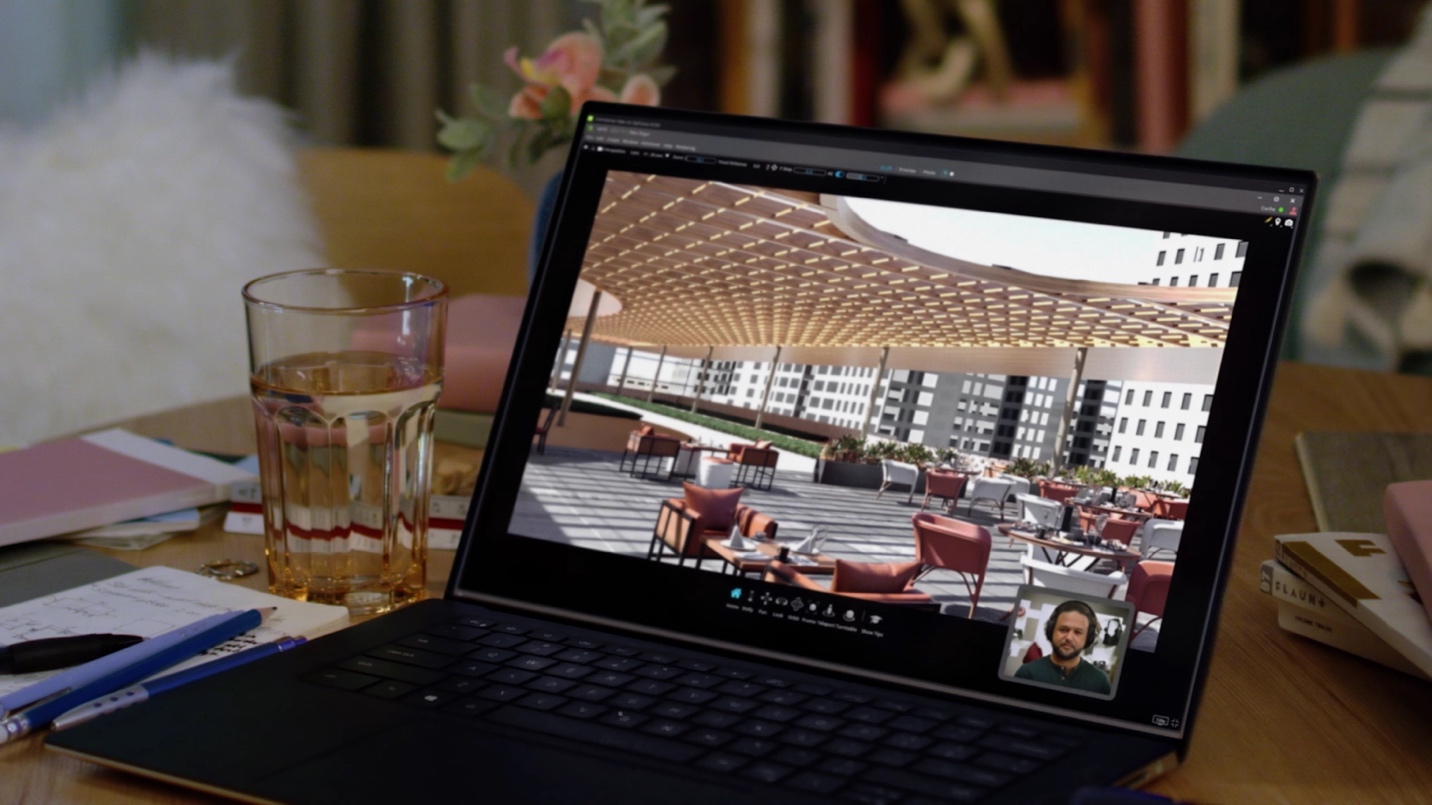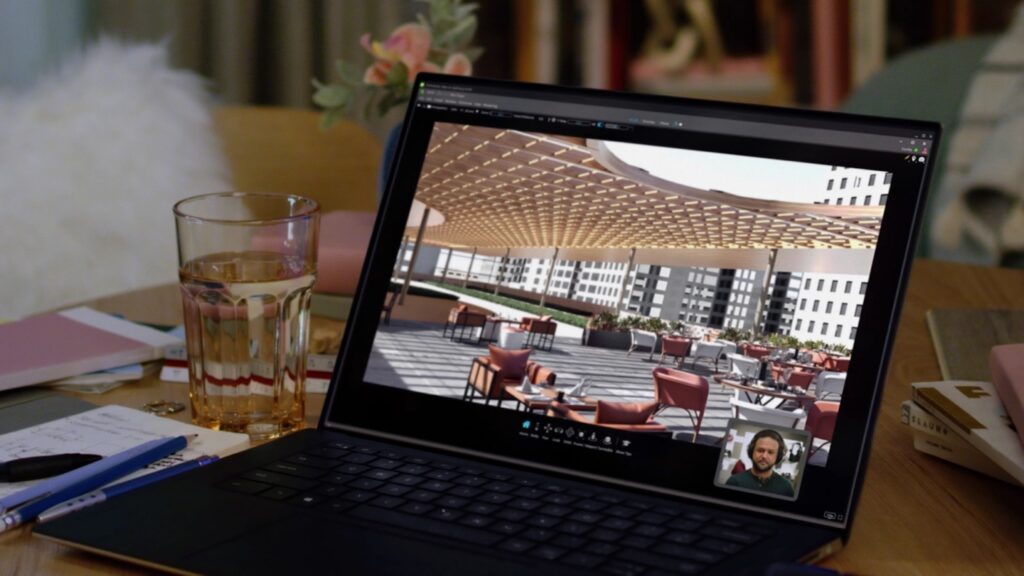Offers new features and functions for a wider audience.

If you are not using Nvidia’s Omniverse, Nvidia sure wants you to.
Omniverse is Nvidia’s multi-GPU-enabled open platform for real-time 3D design collaboration and virtual world simulation used by artists, designers, and creators. It is built on top of Pixar’s Universal Scene Description (USD), enabling users to work with content from different software programs. As such, Omniverse users on disparate applications can work collaboratively and interactively with large datasets.
First off, many have questioned whether Omniverse is the same as the metaverse. Yes, and no. The metaverse—a word constantly being tossed about—is a space consisting of a developed virtual world and interconnected virtual worlds. Omniverse is a virtual environment, but it is a creative space, Nvidia’s branded product, that offers many of the tools needed to build things for the metaverse.
According to Nvidia, more than 150,000 people have downloaded Nvidia Omniverse for creating and connecting virtual worlds since it became publicly available late last year. If you have not been enticed to use it since the platform became available—free for individual users starting early this year, and at a subscription for professional teams since launch—then perhaps the spate of new releases and updates announced at GTC 2022 may draw you in.
After a long beta, Nvidia began selling the enterprise version of the Omniverse platform, and engineers and designers jumped on board. Offering the ability to simulate physically accurate 3D scenes and real-time shared collaboration, Omniverse proved to be quite the attraction for this group of users.
But wait, engineering and manufacturing types aren’t the only ones who can benefit from Omniverse. And in early January, Nvidia made Omniverse, along with new features and tools, available to a much wider user base by offering a free version to individual creators and artists—specifically those using Nvidia Studio powered by GeForce RTX and Nvidia RTX GPUs.
With the various announcements this week, Nvidia is inviting an even more diverse group into the Omniverse fold.

Omniverse Cloud
With Nvidia’s newly detailed Omniverse Cloud, artists, designers, developers, and creators will be able to access Nvidia’s burgeoning Omniverse platform for 3D design, virtual collaboration, and real-time simulation instantly via the cloud utilizing Nvidia’s GeForce NOW platform currently used for streaming games. Moreover, with Omniverse Cloud, users will be able to leverage Omniverse on a wide range of devices, thereby opening the doors to a plethora of potential users who had been locked out of Omniverse because they lacked an RTX-based system.
Nvidia had touched on Omniverse Cloud at CES 2022 in January, but in his GTC keynote, Nvidia founder/CEO Jensen Huang followed that up with more details at Nvidia’s virtual GTC 2022 conference this week.
At the center of Omniverse Cloud is Nucleus Cloud, a collaborative one-click tool that will enable users to easily invite other collaborators to share Omniverse scenes instantly by sending them a link, thus eliminating the need to transfer large datasets and have Nucleus deployed locally or in a private cloud.
In addition, Omniverse Cloud contains two familiar apps that can be streamed using Nvidia’s GeForce NOW platform, powered by RTX GPUs in the cloud. The Omniverse Create app enables users to construct complex 3D worlds interactively and in real time by leveraging Pixar’s USD for scene assembly, lighting, simulation, and rendering. Meanwhile, the View visualization app enables non-technical users to present and review full-fidelity models within dynamic Omniverse scenes in real time.
“A new wave of work is coming that can only be done in virtual worlds,” said Huang during his conference keynote. “Omniverse Cloud will connect tens of millions of designers and creators, and billions of future AIs and robotic systems.”
The Omniverse Cloud collection is under development. Nvidia is accepting applications for early access for the Nucleus Cloud one-click sharing.
Omniverse Connectors
Nvidia has been growing the Omniverse ecosystem with Connectors, extensions, and asset libraries. Connectors are plug-ins that enable live-sync collaborative workflow between third-party design tools and Omniverse. In January, there were just over a dozen Connectors to applications such as Autodesk’s 3ds Max and Maya, as well as Epic Games’ Unreal Engine. Nvidia said those have now grown by 10×, with 82 connections now through the Omniverse ecosystem, making the platform more accessible and easier to use than ever before.

At GTC 2022, Nvidia announced its latest Omniverse Connectors and asset libraries spanning industrial automation, 3D design, and rendering. New CAD importers convert 26 common CAD formats to USD. New asset library integration lets users search and import close to a million Omniverse-ready 3D assets, including those from TurboSquid by Shutterstock, Sketchfab, and Reallusion ActorCore. New Omniverse-ready 3D assets, materials, textures, avatars, and animation also are available from A23D.
To whet your appetite for Omniverse further, Nvidia users can now integrate and switch between their Hydra delegate-supported renders and the Omniverse RTX Renderer directly within Omniverse Apps. This capability is available in beta for Chaos’ V-Ray, Maxon’s Redshift, and Otoy’s Octane, while support for Blender’s Cycles and Autodesk’s Arnold is expected soon, according to Nvidia.

Omniverse is not limited to offerings from third parties, however. User can build their own Omniverse extensions, apps, or microservices though Nvidia Omniverse Code, an app that serves as an integrated development environment (IDE). The new Omniverse Code includes the Omniverse Kit SDK along with foundation tools, templates, and documentation.
New connections were also on tap for industrial automation and digital twin software developers. Among them is LumenRT for Omniverse, powered by Bentley Systems’ iTwin that brings engineering-grade physically accurate visualization to Bentley’s large customer base.

In yet another Omniverse-related announcement, Nvidia unveiled OVX, a computing architecture for running large-scale digital twins within Omniverse. OVX will be used to operate complex simulations that will run within Omniverse, resulting in real-time physically accurate digital twins and extremely large true-to-reality simulation environments.

“Physically accurate digital twins are the future of how we design and build,” said Bob Pette,
vice president of professional visualization at Nvidia. “Digital twins will change how every industry and company plans. The OVX portfolio of systems will be able to power true, real-time, always-synchronous, industrial-scale digital twins across industries.”
With data center-scale OVX systems, users will be able to simulate complex digital twins for modeling entire buildings, factories, cities, and more. This is done by combining high-performance GPU-accelerated compute, graphics, and AI, with high-speed storage access, low-latency networking, and precision timing. The OVX server comprises eight NVIDIA A40 GPUs, three NVIDIA ConnectX-6 Dx 200Gbps NICs, 1TB system memory, and 16TB NVMe storage. The system will be able to scale from a single pod of eight OVX servers, to an OVX SuperPod of 32 OVX servers connected with Nvidia Spectrum-3 switch fabric or multiple OVX SuperPods. OVX will be available this year through Lenovo, Supermicro, and Inspur.
Nvidia announced many other tools and capabilities for Omniverse, as well, all with the aim of making the platform more useful and more enticing for creators and designers across a wide swath of industries. The company also announced various offerings outside Omniverse, if you can imagine such a thing.






